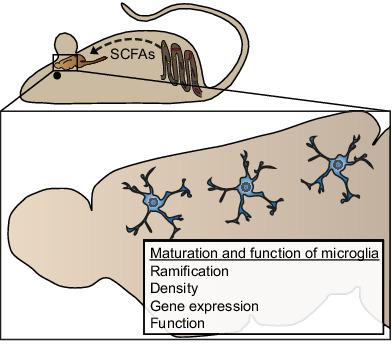Our official English website, www.x-mol.net, welcomes your
feedback! (Note: you will need to create a separate account there.)
How microbiota shape microglial phenotypes and epigenetics.
Glia ( IF 5.4 ) Pub Date : 2020-03-17 , DOI: 10.1002/glia.23822 Daniel Erny 1, 2 , Marco Prinz 1, 3, 4
Glia ( IF 5.4 ) Pub Date : 2020-03-17 , DOI: 10.1002/glia.23822 Daniel Erny 1, 2 , Marco Prinz 1, 3, 4
Affiliation

|
Among the myeloid cells in the central nervous system (CNS) microglia are the main representatives of the innate immune system. Microglial fulfil tasks beyond phagocytosing debris and host defense against invading microorganism. During brain development microglia guide for example neurons for proper CNS formation, in adulthood they maintain tissue homeostasis and in aging microglia may become pro‐inflammatory and finally exhausted. Recently, several endogenous and exogenous factors were identified that essentially shape the microglial phenotype during both steady‐state and pathological conditions. On the one hand, microglia receive inputs from CNS‐endogenous sources for example, via crosstalk with other glial cells and neurons but on the other hand microglia are also highly modulated by external signals. Among them, host microbiota—the host's resident bacteria—are vital regulators of the CNS innate immune system. This review summarizes key extrinsic and intrinsic factors, with special focus on the host microbiota, that essentially influence microglia functions and states during development, homeostasis, and disease.
中文翻译:

微生物群如何塑造小胶质细胞表型和表观遗传学。
中枢神经系统 (CNS) 小胶质细胞中的髓样细胞是先天免疫系统的主要代表。小胶质细胞完成的任务不仅仅是吞噬碎片和宿主防御入侵微生物。在大脑发育过程中,小胶质细胞引导例如神经元正确形成中枢神经系统,在成年期它们维持组织稳态,而在老化的小胶质细胞可能会促炎并最终耗尽。最近,确定了几种内源性和外源性因素,它们在稳态和病理条件下基本上塑造了小胶质细胞表型。一方面,小胶质细胞通过与其他神经胶质细胞和神经元的串扰接收来自 CNS 内源性来源的输入,但另一方面,小胶质细胞也受到外部信号的高度调节。其中,宿主菌群——宿主' s 常驻细菌——是中枢神经系统先天免疫系统的重要调节剂。本综述总结了关键的外在和内在因素,特别关注宿主微生物群,它们在发育、体内平衡和疾病过程中对小胶质细胞的功能和状态产生重大影响。
更新日期:2020-03-17
中文翻译:

微生物群如何塑造小胶质细胞表型和表观遗传学。
中枢神经系统 (CNS) 小胶质细胞中的髓样细胞是先天免疫系统的主要代表。小胶质细胞完成的任务不仅仅是吞噬碎片和宿主防御入侵微生物。在大脑发育过程中,小胶质细胞引导例如神经元正确形成中枢神经系统,在成年期它们维持组织稳态,而在老化的小胶质细胞可能会促炎并最终耗尽。最近,确定了几种内源性和外源性因素,它们在稳态和病理条件下基本上塑造了小胶质细胞表型。一方面,小胶质细胞通过与其他神经胶质细胞和神经元的串扰接收来自 CNS 内源性来源的输入,但另一方面,小胶质细胞也受到外部信号的高度调节。其中,宿主菌群——宿主' s 常驻细菌——是中枢神经系统先天免疫系统的重要调节剂。本综述总结了关键的外在和内在因素,特别关注宿主微生物群,它们在发育、体内平衡和疾病过程中对小胶质细胞的功能和状态产生重大影响。











































 京公网安备 11010802027423号
京公网安备 11010802027423号